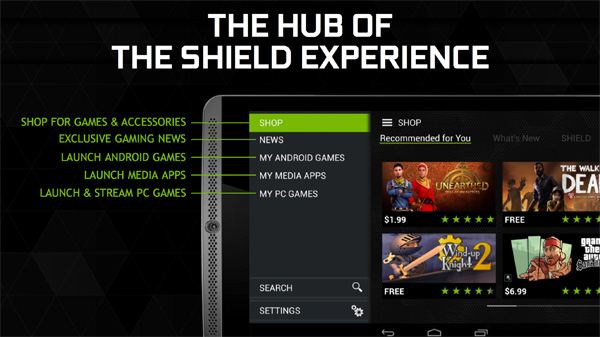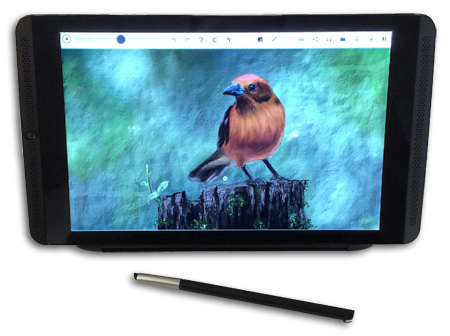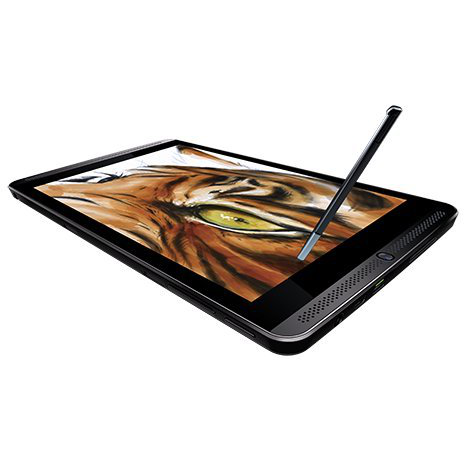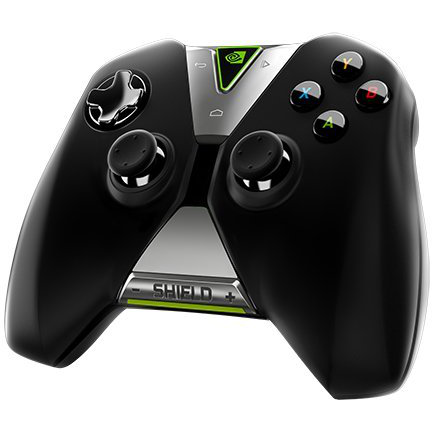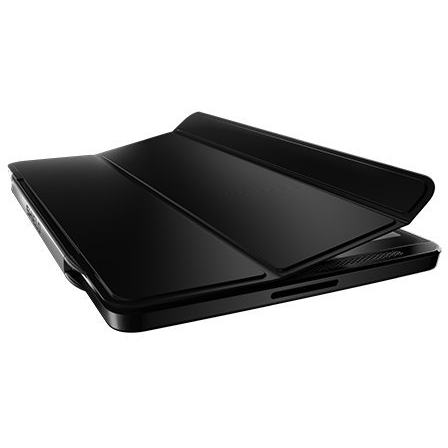Nvidia Officially Unveils the Shield Tablet and Shield Controller
The Shield Tablet advances both mobile media consumption and gaming by combining the best features of the Tegra Note 7 and Shield handheld gaming device into a compelling mini tablet and wireless controller.
Software and Stylus
Software
The Shield Tablet will ship with Android 4.4 KitKat and will allow you to move videos, music, images, etc. to the microSD card (it supports up to 128 GB). The ability to move app or game files depends on developer support. It’s nice to see Nvidia provide a stock Android experience devoid of unnecessary clutter. The only additions are some options specific to the Shield Tablet in the settings menu and a few of Nvidia’s own specialized apps.
The Shield Hub app, shown in the image above, is the primary interface for all the gaming features that make the Shield Tablet unique. The uncluttered UI works equally well when viewing it on the tablet or on a TV while sitting on the couch. While the Shield Hub is a standalone app, it can function almost like a customized launcher. From within the app you can shop for Shield optimized games and accessories, read gaming news, launch any of your Android games, launch media apps (the apps included here are customizable), and launch GameStream.
Stylus Support and a New Painting App for Digital Artists
The Shield Tablet comes with DirectStylus 2, an upgraded version of the inking technology found in the Tegra Note 7. DirectStylus uses a normal capacitive stylus and does not use an active digitizer. Nvidia’s solution is unique however, drastically improving upon the usual capacitive writing and drawing experience. I had an opportunity to play with DirectStylus 2 on the Shield Tablet and was thoroughly impressed.
The included chisel tip stylus doesn’t obscure the point of contact with the screen like standard capacitive styli and creates much finer lines. When using the standard pen type, there is virtually no lag between the tip and the trail of ink. After giving up trying to use a stylus with the iPad, it’s a pleasant surprise to find such a natural writing experience on a tablet that costs less than $500.
Along with DirectStylus 2, the Shield Tablet has built in multi-language handwriting recognition. Unlike other handwriting engines that send your scribbles off to the cloud for OCR processing, the Shield Tablet utilizes the Kepler GPU for onboard processing. I’m not sure what the impact on battery life will be, but in my limited testing word recognition was snappy and accurate.
To take further advantage of DirectStylus 2 and the Kepler GPU, Nvidia created an all new drawing/painting app called Dabbler that people more artistic than I am will appreciate. The app uses the GPU to apply 3D lighting and texture effects and even physics to your artwork. For example, when painting with watercolor, you can see the paper “absorb” the paint (the paint loses its sheen as it absorbs and dries). Oil paint has a noticeable 3D look as you can build up layers and use a chisel tool to cut away the layered paint. The lighting tool allows you to dynamically change the orientation of the light source, which has a dramatic effect on the highlights and shadows of the 3D painting. There’s even a gravity mode that can be enabled that uses the gyroscope to sense orientation and effect the flow of the paint. If too much paint is applied, it will start to run down the canvas.
The Dabbler app currently doesn’t support pressure sensitivity, but Nvidia said this will be coming in the future.
Get Tom's Hardware's best news and in-depth reviews, straight to your inbox.
Current page: Software and Stylus
Prev Page Design and Features Next Page Wouldn't You Prefer A Nice Game Of Chess?-
TechyInAZ Cool! What a great tablet for not just gaming, but it can also be a great productivity powerhouse.Reply -
DarkSable ... seriously Tom's?Reply
Websites have been proclaiming the end of the world as we know it (or at least of desktop computers) for years now, and it's all just built on itself. The reason desktop sales have declined marginally is because most home users already have a desktop fast enough for their needs, and only need to replace it when it breaks.
The other reason is that people have leapt headfirst into the pile of hype that surrounds tablets, which means they're going to see great growth... right until they hit market saturation. -
InvalidError Reply
Tablet sales have already started to slow down; probably in large part due to tablet specs having remained mostly stagnant for much of the past two years. I hoped the N7-2013 would start a flood of decent ~$200 devices but it seems most of the sub-$300 segment just continued filling up with devices having specs closer to the N7-2012 instead.13776476 said:The other reason is that people have leapt headfirst into the pile of hype that surrounds tablets, which means they're going to see great growth... right until they hit market saturation.
PCs on the other hand are getting bumper sales on the back of companies being forced off XP. -
hahmed330 I have to correct one thing Matt... You can use Nvidia Grid Streaming from anywhere, but obviously you need latency of less then 40ms and 10mbit download speed for a great experience. I am seriously looking forward for the whole review though. Direct Stylus 2 looks really interesting. Hopefully Remote Gamestream has come out of beta.Reply -
TheMentalist People always open their mouth saying the shield is worthless. It's the best hardware you get for the money!Reply -
DarkSable Guys, read what I was saying.Reply
Never did I say that the Shield, or the shield tablet, was worthless - I think they're great pieces of tech.
I was annoyed with Tom's Hardware for perpetuating the absolutely faulty myth, which has been around for at least five years now, that desktop computers are "on their way out" and that we should all give up and buy mobile devices.
I have a 3ds and a nexus 5, both of which I like to game on... but that doesn't mean I'm giving up my gaming computer, or that gaming computers aren't going to exist in a few years. -
kamhagh That Price is amazing!!!! Also i agree with darkdable,,Reply
Phones will NEVER replace pc, well at least not for next 80 years! And touch is the worst kind of input, specially for gaming, but its portable and good! Ita good to play awesome games outside and bring it with you, but still, its not pc!!! Pc is amazing, mouse and keyboard, huge screen, -
InvalidError Reply
Well, Intel is putting more effort in their laptop/mobile/embedded R&D and still pushing power-efficiency across the board, Nvidia adopted a mobile-first design mentality, AMD is moving to a heavily if not exclusively APU-centric device lineup, etc.13777299 said:I was annoyed with Tom's Hardware for perpetuating the absolutely faulty myth, which has been around for at least five years now, that desktop computers are "on their way out" and that we should all give up and buy mobile devices.
They might not be dropping desktops overnight but they are all moving in the same general direction: towards a future of mostly low-power if not mobile/embedded systems.
XP maintaining a ~30% market share until Microsoft dropped public support for it is living proof that many people and applications do not need anywhere near as much processing power as today's entry-level systems provide. Intel's Q2 report says ASPs have dropped by 3%, meaning that a fair chunk of Intel's end-of-XP bumper sales are for lower-end/lower-cost chips. This is not going to get better. -
airborne11b I love this new design. It's a mobile gaming powerhouse and if you combine it with a controller that attaches to the device itself, you get one hell of a mobile gaming device with a huge screen that also doubles as a really powerful android tablet.Reply
PC streaming, GRID, Console Mode, Tegra K1 fueled android gaming, Direct2 Stylus, full android OS backed by serious processing power.
All for $299. I can't wait to get my hands on it.
I also sent an email asking when the STG-ONE tablet-attachable controller will be released. I'll reply back here if I get a response.
